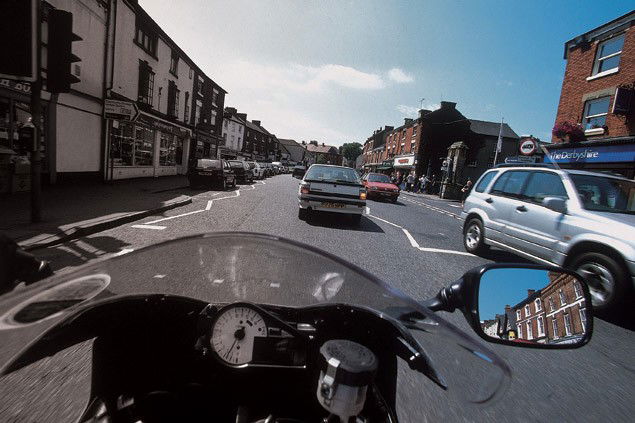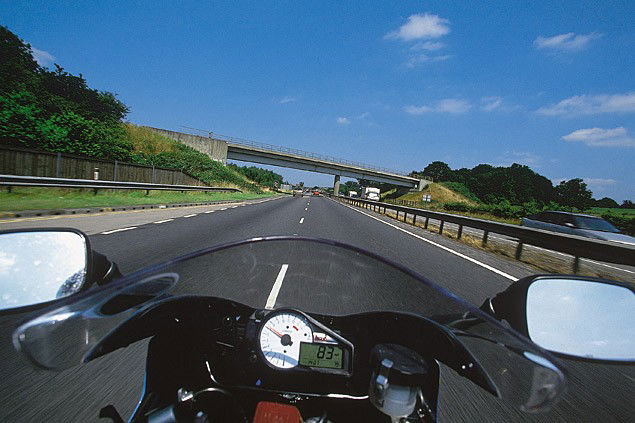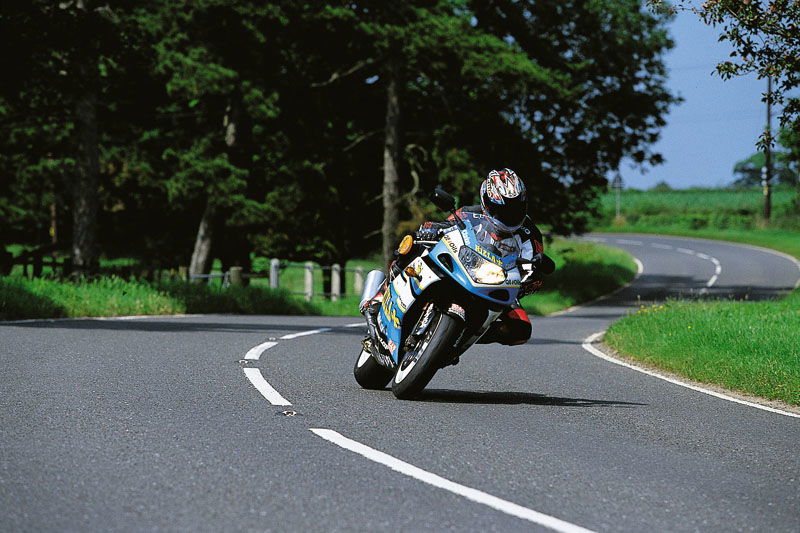Ride Like Mackenzie: Road Survival
Join the one and only Niall Mackenzie as he divulges everything he knows about faster, smoother, safer riding, on the road and track, all of it gained from the highest levels of world competition and through 24 years of road riding experience

Now I know road survival sounds about as fun as watching paint dry while listening to Will Young's greatest hit, but bear with me. Obviously it'll never be as sexy as learning to hoist massive stand-up wheelies or how to slot in a sub 1.36-second lap of Donington, but as the road's where we all spend most of our time then staying alive while we're there is really rather useful. It also means we can get to our next trackday/deserted backroad stretch faster, smoother and more safely. So actually, road survival is a very good thing, and without it we'd all be, umm, not alive and that would be bad so sit up straight at the back and pay some bloody attention.
Hopefully you all got on alright with last month's homework and can now demolish roads you know just as well as those you don't, cutting a swathe through your local countryside with all the grace and majesty of an eagle soaring above the highland lochs and glens, feathers fluttering in the crisp Scottish air, and... sorry, getting a bit carried away there, but you get the point.
But now we have a lesson to get on with so let us away for a ride through some everyday terrain and a bit of a chat, starting in town...
Town Techniques

Town Techniques
It's early morning, you rolled out of bed 20 minutes ago, haven't had your Wheeto-Flakes and your attention levels are that low they're bobbling around your ankles as you pull out of the drive. 'Never mind', you think, 'I'll perk up in a bit'. And sure you will. Just remember everyone else in cars around you is in the same early morning daze, probably even more so as Radio 2 soothes them through the traffic, so they're more likely than normal to something daft.
Apart from the general rush hour chaos at either end of the day, watch out for the school run mayhem just beforehand. With kids to drop off/collect myself I know what a war zone this one is - no parking spaces, kids running everywhere, worn out hassled parents with road rage pouring out of their ears. Everyone here is waiting to dive into your path. And beware chucking out (up?) time at night too. From 11pm until 3am the streets are awash with u-turning cabbies, meandering drunks and half-blind drink drivers.
And now we're away, pottering through town, and it's time for some filtering - no point in having a bike if you're just going to sit in queues all day long is there? The biggest problem with filtering is it only needs the car next to you to move a foot or two to have you off, so you've got to watch them like a hawk.
Check driver's heads through the rear window - they'll move before the car does, and watch their front wheels too. You'll see these move before anything else and they're the best early warning of an imminent sudden lane change or junction pull-out.
Mind any gaps appearing in the queue ahead of you - it could be someone stopping to let another car pull out of a side road straight into your filtering path...
In the shot above the car ahead's turning right, so we'll just nip down the inside. Simple? Well, kind of.
You'll want to watch those parked cars on the left for anyone opening a door (if you can see someone in the driver's seat, always leave a door's width as you pass), check over your shoulder for any other bikes filtering behind you (but do it fast - a slow lifesaver'll see you in the back of that car before you know it), and mind the car indicating right doesn't swing left before turning right or doesn't give up on the turn altogether.
It's worth hanging back from big vehicles like this lager truck above because you'll get a better view of what's ahead. Also, pedestrians have a nasty habit of running out in front of stuff like this - buses are a classic for this but at least you can see through them thanks to all that glass - so again, a bit of distance is a good idea.
As is covering the brakes. I tend to drag the back just to slow down gently in traffic - it's smoother than chopping on and off the throttle - and I'll always have one finger covering the front brake. It can save vital fractions of a second if you suddenly need to haul up, and one finger as opposed to all four helps avoid you grabbing a fistful of brake too and locking the front.
Now we're on our way out of town, but check out this petrol station coming up on the right (below) - these, pubs and lay-bys are the major hotspots cars suddenly pull into (and out of) without warning or looking. Don't even think about overtaking here.
Just hang back, chill out and cover the brakes.
And chilling out is, as with all other parts of riding, the key to successful town, motorway and open road boogie. There's no point in road rage, no point in mad thrashes between traffic lights and no point in caning between lanes of traffic at a million miles an hour - it'll only be a matter of time before you end up as human jam on someone's bonnet. Take it smooth and easy on the other hand and you might even enjoy it.
Motorway Miles

Motorway Miles
Right, so we're out of town and onto the motorway. Surely the best place to get your head down and go as fast as possible for the minimum effort? Well, sort of.
On a licence-saving note, the motorway's a quality place for getting nicked, so watch those bridges and roadside perches for marked cars timing you, and consider turning your headlight off in daylight if its clear - just makes it harder for the police to spot you from miles
away.
Cast your mind back to lesson two (accelerating and braking) and you'll remember we talked about slowing down on engine braking rather than using brakes, and on the motorway this can be a nice smooth way to regulate your speed to the surrounding traffic. Just remember though if you are relying on engine braking you won't be showing any brake lights to any cars behind, so even if you don't actually need them, brush the lever if you are losing some major speed to save yourself getting rear-ended.
And as with any road riding, position is key. It's all about giving yourself the best possible view of what's ahead, but on the motorway it's also a case of making sure cars in front have seen you. So avoid riding in anyone's blind spots whenever possible, and if you're coming up on a slower car in the outside lane, move about a bit so they can see you in their wingmirrors - especially with a headlight on this'll normally shift most of 'em pretty rapido.
Give yourself plenty of safe space around you whenever possible too and keep as much space between you and any possible hazards as you can. So if you're in the outside lane passing people, keep to the outside of the lane rather than riding next to their doors, it just increases your safety margins should someone swerve your way.
But, there are always times when cars won't move out of your way either because there's too much traffic ahead like here, or because they're plain old stupid and here we enter the murky world of motorway filtering. It's a legal grey area, but assume a gentle inside pass on a couple of cars is okay if you look responsible, while 170mph for eight miles down the hard shoulder will probably see you in chokey playing mummies and daddies with Mr Big sharpish.
If you are going to filter on the motorway, passing cars when they're alongside one another is probably the best bet as they're less likely to change lanes with another car there.
When the motorway really clogs up as the M25 does daily, take it real easy as everyone slows down - this is where everyone's jockeying for position and changing lanes every two seconds just to get six inches further forwards before grinding to a halt. Once it's settled and you're filtering, stick your main beam on to make doubly sure people can see you and watch for front wheels or driver's heads turning as an early warning of someone pulling blindly into your path. Don't be scared to use your horn or rev your engine if you think you haven't been spotted.
Country Practice

Country Practice
Now we're on the open road, blasting a bit here and there and generally getting ready for some fun.
Golden rule when speeding things up a touch on the open road is to get your road positioning right. Just the same as in town and on the motorway you're looking to keep as much distance between you and any hazards as possible while maximising your forward vision.
So, in the case below you want to be as far away from the approaching junction on the left in case someone appears in it and pulls out - if the road was clear and there were no junctions on the other side there'd be no harm in using the other side of the road to be doubly safe. But in this case you'll want to moderate your position to account for the junction on your right and the car in it. Somewhere in the middle of the road is about right here.
Conclusion
Conclusion
The stuff we've covered today may not be the most interesting in the world, but it's the stuff that'll keep you alive.
The basic rules are always the same - aim to keep a buffer area between your bike and approaching hazards whether you're in town, on the motorway or out on the open road, constantly alter your road position to do this and, where possible, to optimise your forward vision, and only use real speed when the roads are clear.

Niall's Homework
Bit of a month off for you this month because I've not got any fiddly exercises lined up, more a kind of general project which is to simply get out there and ride in town, on the motorway and out in the sticks because even though you can read about all the theory behind this lot until you're blue in the face, it's only by getting out there and trying it that it'll really start to make sense. Extra brownie points to anyone who spends the day riding in central London though...

